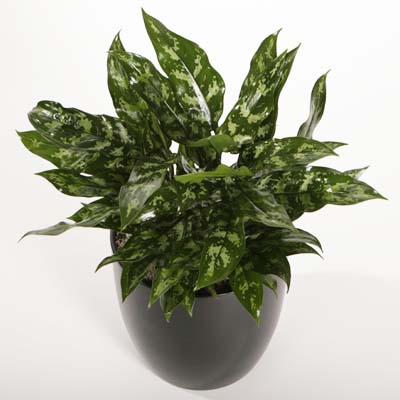Common Name: Aglos; Chinese evergreen
Light Needs
Low to medium light
Water Requirements
Light watering
Description:
Tabletop to knee high decorative bush. Their bloom is a spathe and spadix fashion. The fruit is a bright red/orange berry.
Most commonly used varieties: ‘Silver Queen,’ ‘Maria,’ ‘Emerald Queen’ and ‘Romano’
Tabletop to knee high decorative bush. Their bloom is a spathe and spadix fashion. The fruit is a bright red/orange berry. The thickened stems hold elliptical, elongated foliage in many shades of green. Many have variegation along the major veins. As the plant matures, the weight of the foliage causes the stem to sprawl. In nature, this is a secondary way the plant spreads – by rooting along the stem wherever it touches the ground.
This delightful group of plants is in the Araceae family, making it a close kin to Spathiphyllums and Philodendrons. It’s classified as a rhizomatous herb, slowly spreading. Their inflorescence is unisexual in a spathe and spadix fashion. The fruit is a bright red/orange berry which is seen infrequently in interiorscapes except on A. modestum. The thickened stems hold elliptical, elongated foliage in many shades of green.
Low to medium light (10fc – 250fc). It can survive in a mere 10 foot-candles of light. Aglaonemas do not like direct sunlight. Variegated aglaonemas need bright light and the darker green varieties do well in the shade.
In low light, these plants need to dry down between waterings. Surface soil should be dry at least half way down before you add water. Plants should not stand in water. If media is too wet, stems will get mushy and rot off. If too dry, older leaves turn banana yellow.
Aglos live forever. They need ongoing supervision to keep them looking their best. Grooming is an important function for aglo care. Take off yellowing leaves on a regular basis. Include removing the petiole with removal of the leaf. While you are in the pinching mode, remove the flowers and flower buds. This plant is grown for its decorative foliage and you want its energy to go towards growing new leaves rather than to producing a flower.
As the plant grows in size it will start to flop open. That’s its nature. An aglo bent over and wandering across a table top is not considered attractive so grooming the plant is important. As the plant stem starts to lean out of the pot, it’s time to shorten that stem and begin again. The stem should be cut back to the soil level where a new branch will spring up over time. The cutting should be shortened and inserted into the soil near the outside edge in an attractive manner. Some people like to add rooting hormone to the tip to encourage it to root. When you have unrooted cuttings in your plant be sure to keep the plant a bit wetter than normal and irrigate near these cuttings. Of special note, no aglo should ever need a stake. Even those in very low light. If you are feeling the craving to add one, it’s time to prune that plant back.
Aglos hate to get chilled. Anything under 55 degrees is too cold for them and they will suffer. Their chilling damage can look like the plant got too dry for the leaves turn an odd shade of yellow. Cold damage is a distinctive wet looking brown/black color. Usually it’s slimey to the touch.
These delightfully diverse plants are easy to cultivate with new varieties being brought to market every few years. Growers’ lists frequently include over 15 varieties for interiorscapers. They are grown in 6″-14″ pot sizes and stand from 6″ to almost 5-feet-tall.



